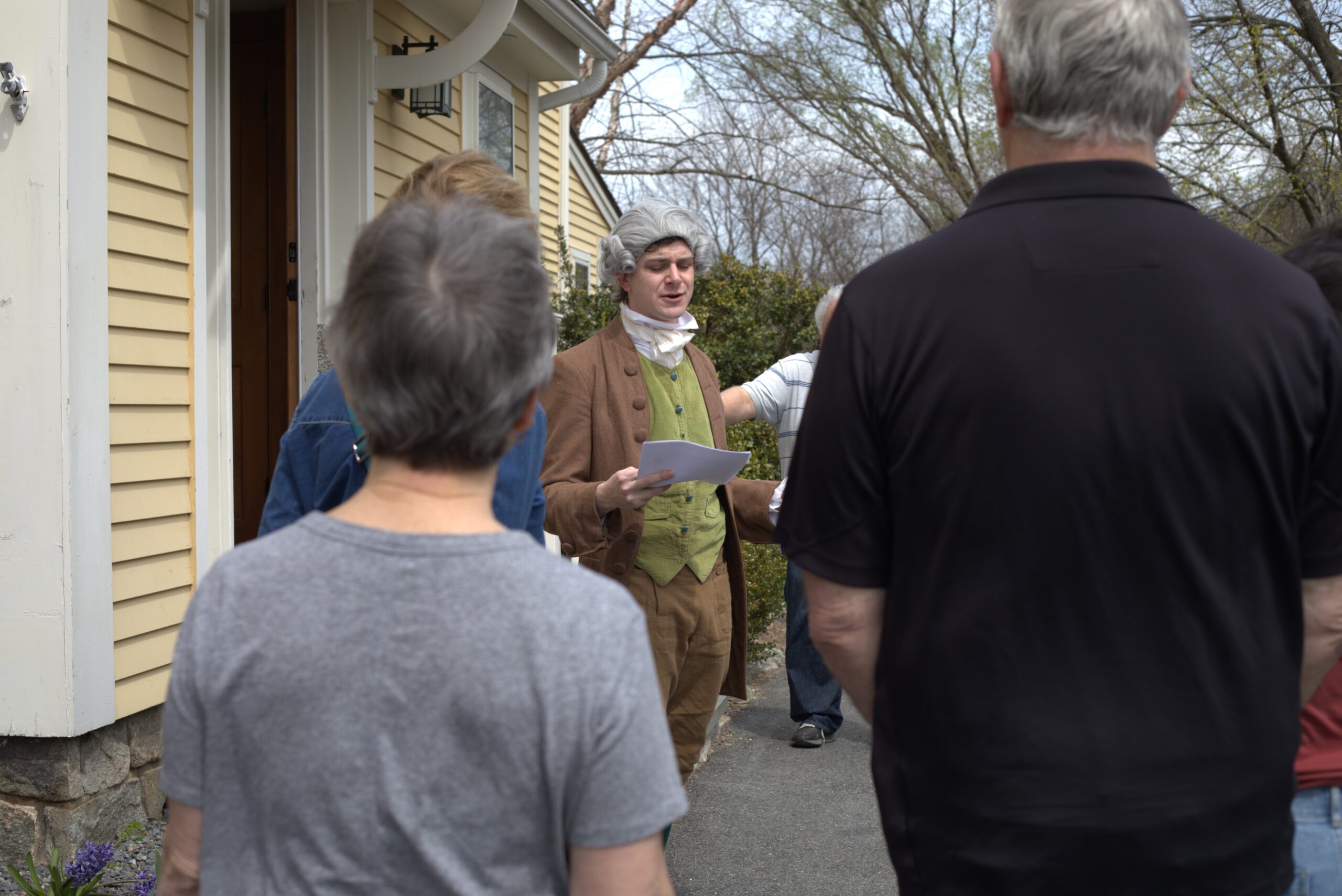It has been 250 years since the American Revolution, but the spirit of those who fought for independence still resonates in the streets of Andover.
On Saturday, Andover and North Andover residents set out on a bus tour to retrace a route that local Revolutionary War heroes took exactly 250 years ago on that day.
Hosted by the Andover Center for History and Culture and the North Andover Historical Society, the April 19 tour was a component of a weekend-long celebration dedicated to local revolutionary figures and landmarks.
The day began with tour leader Martha Tubinis providing an introduction to the origins of Andover. She said that in 1646, Andover—called Cochicawick at the time—was bought by Ipswich and Newbury men from Native American leader Cutshamache for “six pounds and a coat.”
“That’s a story for another day,’’ said Tubinis, who recounted the history of the names of Andover’s streets, meeting houses and churches.
The tour started in present-day North Andover, stopping by the Timothy Johnson House, and two burial grounds on Academy Road that host the plots of Revolutionary War soldiers. The tour then wound through the streets of Andover, stopping at the Blanchard Upton House on Hearthstone Place, and passing the site along the Shawsheen River of the 1776 Gunpowder Mill used by Minutemen and also criticized by George Washington
This story was published as part of a collaboration between Andover News and the Department of Journalism in Boston University’s College of Communication. The student journalist is a member of Professor Meghan E. Irons’s Reporting in Depth class.
Tubinis, the director of programs at the Andover Center for History and Culture, highlighted key figures who helped shape Andover and the emerging nation. Among them: Captain John Lee Jr., who marched with the militia in 1775; James Otis Jr., a fiery orator and early advocate of colonial rights; Samuel Phillips, founder of Phillips Academy and co-creator of the gunpowder mill, and Eliphalet Pearson, prominent educator.
The mill played a crucial role in the war, though not without controversy as Washington complained about its output, writing, “There must be either roguery or gross ignorance in your powder makers.”
The bus traveled a route that passed 24 homes from the 1775 era, many of which belonged to residents who contributed to the American Revolution.
David Blauvelt, North Andover Historical Society’s Museum educator and tour guide, explained that Andover had a strong military presence leading up to April 1775.
“Every man 16 years or older had to be part of the town’s militia,” said Blauvelt.
After seeing the site of the mill, tour-goers followed the path of the Andover militia on “the road to Billerica,” the very route taken on April 19, 1775.
The tour made two stops where participants could step inside historic 18th-century homes. One stop was at North Andover’s Timothy Johnson House, built in 1711. It was once home to Colonel Timothy Johnson, a prominent militia leader.
The tour also stopped at the Blanchard Upton House, 7 Hearthstone Place in Andover. In 1775, the home was owned by Josiah Blanchard, an Andover resident involved in the Patriots’ cause.
Current homeowner Joann Michalik led guests through the original two-room layout, explaining its thick “Indian walls” as they were called, which were packed with brick to help prevent fire.
“More than 50 percent of all houses were in that configuration at the time,” she explained.
Michalik also explained that houses during that time had a “widow’s room” that provided some living security in the event of the homeowner’s death.
“When the owner of the house passed, his widow was guaranteed a portion of the property — typically 20 to 30 percent — and the oldest son would get ownership,” she said.
Kathy Stevens, a volunteer from the North Andover Historical Society, recounted Andover’s famously delayed arrival at the Battle of Lexington when militiamen first met at North Parish church and then began their march.
“They marched to Lexington, but on the way stopped for lunch in Billerica, making them too late for that battle,’’ she said. “However, they did participate in the war later.”
That moment was captured in the diary of James Stevens, an Andover resident and Continental Army private whose wartime writings are now displayed in the society’s exhibit.
Visitors could also climb the steeple of North Parish Church, which houses a 1,290-pound Paul Revere bell, cast in 1806.
The church, built in 1836, also features a historic organ and clock mechanism, all detailed in volunteer-led tours that revealed the craftsmanship of early New England.
Kirk Olsen, a board member of the church, shared a surprising detail workers found while doing a recent restoration — the clapper of the Paul Revere bell had been heated and spun, an unheard-of method in the repair of these bells.
“The bell guy was like, ‘You wouldn’t believe what I found. I sent a picture to our company president. He’s never seen this before,’” said Olsen.
The weekend’s events were not only about honoring the past but also about connecting the community to the present.
“This is a way for all of us to learn from the past and in some way save our history,” said participant Michael Lenihan.
For those eager to continue exploring Andover’s Revolutionary roots, the Andover Historical Society will host a special event on June 21, marking the 200th anniversary of General Lafayette’s return to the United States.
Lafayette visited Andover in 1825 and spent time with local veterans—another reminder of the region’s deep Revolutionary ties.

